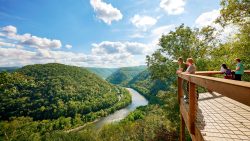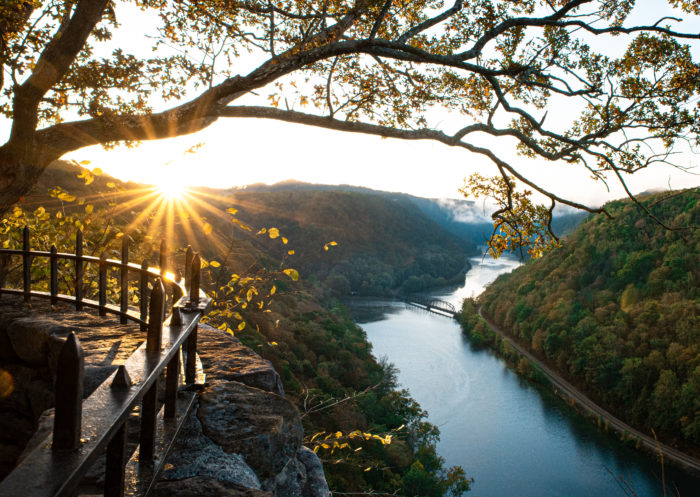Different types of skiing in the mountain slopes
Resort, freestyle, glade, backcountry, telemark: what does this all mean?
Here’s a quick primer on the equipment and styles that you can use to glide down West Virginia’s wild, wonderful slopes (and scenery)!
First, the equipment:
1. Downhill Skis
By far the most common way to enjoy the slopes is with a pair of downhill (also called Alpine) skis. These heavy, relatively short skis have metal edges and curved shapes that make turning a breeze, even for beginners.
The heavy plastic boots clamp your toes and heels to the ski, although you can also adjust the tension of the foot bindings– beginners will want their bindings a bit looser so that the skis will fall off if you make a mistake to avoid potential knee or ankle injuries.
If you’re new to the downhill skiing, Winterplace was named the best place for beginners to learn.
2. Cross-country Skis
Skinnier, longer and lighter than downhill skis, these quickly glide across flatter surfaces. Cross-country skis also have a deeper “camber” than downhill skis– if you look at them from the side, they have a springy arch so that when you lift your foot to glide, only the front and back of the ski is touching the snow.
The boots are very light– about the same as a pair of heavy hiking boots– and only the toe is fixed to the ski, so you can lift your heel as you kick and glide across the snow.
White Grass is renowned as an East Coast cross-country gem.
3. Telemark Skis
Do you want the freedom to move cross-country across the flats, but the control of downhill skis on slopes? Then check out telemark skis.
These feature a fixed-toe and free heel, but on heavier-duty skis that are fatter, metal edged and have less of a curve than cross-country. They are true all-arounders for going anywhere in the backcountry you want, but turning requires a bit more technique and training than regular downhill skis.
4. Snowboards
If you have a background as a skater or surfer, you’ll almost certainly gravitate toward snowboarding rather than skiing at the resorts. Strap your heavy boots into a board that is just a bit smaller than your body, and “carve” turns down the slopes, rocking back and forth on both edges of the board.
It’s very different from skiing, but you can get comfortable on a snowboard with a day of practice on the slopes.
5. Split Boards
Want to take your snowboard into the backcountry, away from the lifts and crowds of resorts? There are plenty of places to do this, but you’ll have to move across the flats and uphill as you make your way to the top of that mountain run.
Strap your board to your back and wear snowshoes, or get a split board. Split boards are snowboards that are actually made of 2 lengthwise halves that can split apart from each other, transforming into a sort of stumpy version of cross-country skis for you to walk up the hills. At the top, put the 2 halves back together and enjoy a snowboard ride down!
These 7 gear stops can outfit you with the right equipment.
Next, the styles of snowsports:
1. Groomed Trails
These are the downhill trails you’ll see at most resorts. You don’t have to worry about unexpected rocks and trees, so this is the place to really fine-tune your turning technique and form before you venture into more rugged terrain.
It is a real treat to be the first person to ski or board down the fresh “corduroy” groomed marks of a trail, and even more special to be able to plow through fresh-fallen powder. Get up early!
2. Glades
If there’s been a lot of snow, it can be fun to break off from the groomed trails and weave your way through glades of trees on your skis or snowboard. It’s usually a bit slower, more adventurous and much more technically demanding.
Sometimes there are pre-established trails on tree runs, but sometimes you glide through untrammelled powder.
You’ll need to be more skilled at maneuvering. Tree branches can hit you, and sometimes there are even “tree traps” that you can get stuck in. Wear your helmet, ski with a partner and be sure to ask about conditions before you go.
Several places in West Virginia have Glade skiing, but if you’re a pro looking for a challenge, Snowshoe has a special expert-only glade area.
3. Freestyle Parks
Most resorts now days have “terrain parks”– groomed trails that also skate-park styled jumps, ramps and obstacles. Expert skiers and snowboarders use these to practice all sorts of tricks and stunts.
4. Backcountry
Backcountry is a very broad style that really applies to any skiing or boarding that is not at a resort.
You’ll want some way to move on flats or uphill, so consider cross-country, telemark, split boards or snowshoes, and enjoy the adventure getting to places that most frontcountry skiers will never see.
The Elk River Touring Center, which borders the Monongahela National Forest, winds out into amazing backcountry trekking.
What will be your snow adventure in West Virginia?
Discover more skiing
This post was last updated on July 20, 2020








